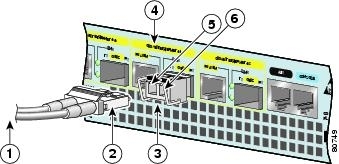- Related articles
- What is multi-mode and single-mode fiber?
- What Is the Importance of Network Interface Card?
- Optical Transceivers for Cisco WS-C2960X-24PSL-RF Switch
- Optical Transceivers for Cisco WS-C3560V224PSS-RF Switch
- Optical Transceivers for Cisco SG300-10PP-K9EU-RF Switch
- Optical Transceivers for Cisco WS-C3650-48TQ-L Switch
- All Cisco WS-G5484's information (List price, Specs, Datasheet PDF, Compatibility matrix)
- Analysis on the performance of common external wireless network card and purchasing skills
- The Things You Need to Know about 100GBASE-ER4 Ethernet Standards
- All Cisco SFP-10GB-SR's information (List price, Specs, Datasheet PDF, Compatibility matri

Definition:
A gigabit interface converter (GBIC) is a standard for transceivers, commonly used with Gigabit Ethernet and fibre channel in the 2000s.[citation needed] By offering a standard, hot swappable electrical interface, one gigabit port can support a wide range of physical media, from copper to long-wave single-mode optical fiber, at lengths of hundreds of kilometers.
The small form-factor pluggable (SFP) is a compact, hot-pluggable transceiver used for both telecommunication and data communications applications. The form factor and electrical interface are specified by a multi-source agreement (MSA) under the auspices of the SFF Committee. It interfaces a network device motherboard (for a switch, router, media converter or similar device) to a fibre optic or copper networking cable. It is a popular industry format jointly developed and supported by many network component vendors. SFP transceivers are designed to support SONET, gigabit Ethernet, Fibre Channel, and other communications standards. Due to its smaller size, SFP obsolesces the formerly ubiquitous gigabit interface converter (GBIC); the SFP is sometimes referred to as a Mini-GBIC. In fact, no device with this name has ever been defined in the MSAs.
Difference between GBIC and SFP
GBIC
- Gigabit Ethernet 1000base-SX/LX/XD/ZX at 1.25Gbs/s Optional
- Wavelength: 850nm/1310nm/1550nm
- Single +3.3V or +5V power supply
- Ho-pluggable Duplex SC
- Eye safety, meet laser class 1, compliant with IEC60825-1
- Compliant with Tecordia (Bellcore) GR-468-CORE
- Compliant with specification for IEEE-802.3
- Compliant with ANSI spec. for Fiber channel applications at 1.06Gb/s
SFP
- Data rate: 155M/622M/1.25G/2.5G/4G
- Wavelength: 850nm/1310nm/1550nm
- PIN/APD photodiode receiver
- SFP MSA PACKAGE DUPLEX LC
- +3.3V single power supply
- With or without DDM function
- Very low EMO and excellent ESD protection
- Distance from SX 550nm to ZX 120km
Applications:
The appeal of the GBIC standard (and hot-swappable transceivers in general) in networking equipment, as opposed to fixed physical interface configurations, is its flexibility. Where multiple different optical technologies are in use, an administrator can purchase GBICs as needed, not in advance, and they can be the specific type needed for each link. This lowers the cost of the base system and gives the administrator far more flexibility. On the other hand, if a switch will mostly have one port type (especially if that port type is copper) purchasing a switch with that port type built in will be cheaper and take up less space per port.
SFP sockets are found in Ethernet switches, routers, firewalls and network interface cards. Storage interface cards, also called HBAs or Fibre Channel storage switches, also make use of these modules, supporting different speeds such as 2Gb, 4Gb, and 8Gb. Because of their low cost, low profile, and ability to provide a connection to different types of optical fiber, SFP provides such equipment with enhanced flexibility.
Mini GBIC SFP Difference:
The SFP package - Hot Swap small package transceiver, the highest rate of up to 10G, using LC interface. SFP (Small Form Pluggable), can be simply understood as the upgrade version of GBIC. The SFP transceiver volume ratio of GBIC transceiver can be reduced by half, in the same panel configuration of many more than doubled the number of ports. The SFP transceiver to other basic functions and GBIC agreement. Some switches manufacturer called SFP transceiver for small GBIC (MINI-GBIC). SFP transceiver is a popular industry format jointly developed and supported by many network component vendors. SFP transceivers are designed to support SONET, Gigabit Ethernet, Fibre Channel, and other communications standards. Due to its smaller size, SFP obsoletes the formerly ubiquitous gigabit Interface converter (GBIC); the SFP is sometimes referred to as a Mini-GBIC although no device with this name has ever been defined in the MSAs. Nowadays, only some of Cisco switches use GBIC transceivers, so the requirement of GBIC transceiver is pretty smaller than SFP transceivers.
Conclusion:
GBIC transceivers and Small Form-factor Pluggable (SFP) transceivers for Gigabit Ethernet and Fibre Channel applications. These small, modular optical interface transceivers offer a convenient and cost effective solution for the adoption of Gigabit Ethernet and Fibre Channel in data center, campus, metropolitan area access and ring networks, and storage area networks.






















































